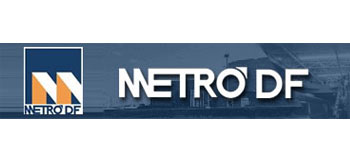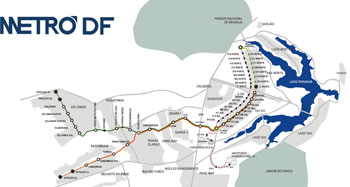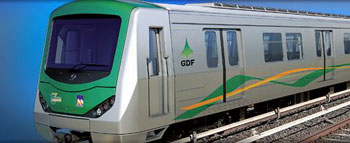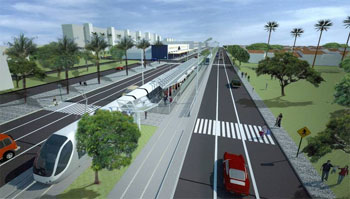Transport in Brasilia: Brasilia Subway
David José de Matos, President Director of METRO DF (Metropolitan Company of the Federal District of Brazil)
The plan of Metro DF is to make Brasilia transport more accessible, including subway, since the current figures show that only 150,000 people make use of the subway transport. This is a very small number when taking into account the size of metropolitan Brasilia – 2,5 million citizens.
Interview with David José de Matos, President Director of METRO DF (Metropolitan Company of the Federal District of Brazil)
Brasilia may seem unique but it shares one basic problem with more traditional cities. The city has been designed for half a million people but currently there are around 2 million people, 2 and half million commuting every day and the satellite cities are up to 25 km around the city. The amount of cars and buses is becoming impossible. There are multiple congestions. What is the current state of the Federal District transport sector?
In reality, the Federal District never had an Urban Transportation Director Plan that would tackle the fact that the pilot plan attracted every day around one million people that come to work in the Federal District.
In fact, transport develops itself in a commuting manner. In the morning, one million people get off the transports at the Federal District, to the Pilot Plan and in the afternoon they return to their homes. This means that the transport in the Federal District has a very short renewal of passengers during its route which leads to the increasing of transport costs and encourages the use of individual transport due to the lack of a solution to the following:  Brasilia was designed for a certain amount of inhabitants and today its growth has surpassed the normal rhythm of growth of cities in the rest of Brazil. The Federal District was not prepared for this.
Brasilia was designed for a certain amount of inhabitants and today its growth has surpassed the normal rhythm of growth of cities in the rest of Brazil. The Federal District was not prepared for this.
Now we have a plan to rebuild this road network in an attempt to make the inhabitants use the public transports more often. This however, cannot be done from one day to the next, we need not only to invest in roads but mainly in the management of the public transport in the Federal District.
For this to happen I would imagine a change in the mentalities is also necessary.
Exactly. We have to make the population leave their cars at home and use the public transport system. For this to happen we have to offer a public transport with good quality that can guarantee them a transport at the time they leave and need to return home after a day’s work and also that the routes we assure are not that far from their homes and workplaces.
Brasilia due to its architectonic display is not very favorable to the pedestrian and makes people want to park their cars right next to their workplace, as opposed to other cities where people walk for more lengths and have a more harmonic relationship with their cities. So the whole public transport topic requires an in depth study and above all management so that the offer of transport brings to the user a sense of tranquility that his/her route to or from work will be done smoothly.
Currently the public transport is not good and not that expensive since it is subsidized largely by the government. So our main focus should now be the management of the public transport. A new management is the key concept. To add to this there is also the fact that the bus sector in Brasilia is run by 3 or 4 entrepreneurs that have exploring in a not so coordinated fashion by the government that even the bus routes are not designed in the most balanced way.
We believe we can reach the amount of 420,000 passengers per day, meaning we will more than double the amount of passengers we currently serve.
As a result we see deficit lines, having to cover for other profitable lines. The subway has joined this system in the 90’s and had a deadline of 5 years to be built. Twenty years have passed and it still hasn’t reached its full potential, so it hasn’t had a corresponding amount of resources devoted to its development. The subway is a system that functions as the backbone while the bus system complements it. The subway has to this day failed to provide the necessary response to the population. This is what we are working on at this moment; we plan to extend the subway to the north wing and also to start working with a light rail system to make possible the integration of the funicular system rails with the urban transport. Brasilia has a characteristic, let us say in the perpendicular direction of the axes it shows a great difficulty to get around.
We have today a central point in Brasilia where 600,000 people pass by everyday which is the Transport Terminal and those people don’t want to go to the terminal. They want to go to the Congress, to the Ministries and there isn’t an efficient public transport to carry those people along the highway. Hence the existence in the public transport system of a project for a Light Rail on the Esplanade of the Ministries which I believe to be of the biggest importance to motivate the middle class to leave their cars at home, go to the terminal and get a transport that can leave them at the Ministry, at the Senate, etc.
The President of Brazil, Dilma Rousseff has announced a $30 billion package of investment in an urban transport project. What is the role you are going to play in this strategic plan? What are the investments you are planning to make and how are you getting ready for the upcoming World Cup 2014 for which Brasilia has been chosen to be one of the host cities?
As I said previously, the public transport in the Federal District lacks a lot of investment and within the program of the Federal District to invest in the mobility aspect of it we are taking the most of what is being offered to us by investing in the Urban Transportation Director Plan where we intend to introduce the Bus Rapid Transit (BRT) that would help solve the issues we face with the cities that are around 30-40 km from Brasilia. We need a fast transport so that the users can comfortably leave their cars at home, knowing that they have a transport at the time they need to return home.
So, these investments in the Federal District in the next years which have the support from the government that is implementing this mobility pack across the whole country is crucial for us to be able to close this road network and then start working internally to restructure the sectors of bus, subway and light rail so that in the future we can address other problems.
Brasilia was predicted to have a population of 500,000 people in 2000. In fact it had 2 million people. A strong migration taking place in the 70 and 80’s contributed to this and it has made the city what it is today. The big Brasilia, the metropolitan city has 2,5 million people but if we consider the surroundings, the state of Goiás, we have 3,5 million people making a huge pressure not only in the public transport system but also in the healthcare and education areas in Brasilia. In fact we believe that when we projected the subway in 1990 we fell short of what we should have.
For example today when I arrived here I saw the subway with 4 cars.At that time, people would say « let’s build it with six, eight cars » but we thought that the prediction of having 2,5 million people in the southwestern part of Brasilia was overestimated. In reality time has passed and we understand we could have dared more. Today the subway cannot answer the demands especially at the rush hour. We need to expand the subway, not only in what concerns the number of cars but also in extension with the help of financed resources and also with our own resources since it is a significant amount we are talking about.
To make those investments, are you looking outside Brazil, trying to attract foreign investors and technology or are you focusing in national resources, local experience?
Today we live in a globalised world, so you can’t just consider your own country. Actually there are currently no borders whatsoever when you think about industry. If you look at the Light Rail companies implemented in Brazil, they are of European, Canadian origins.
Also in the sales made to Rio de Janeiro the Chinese were involved. In Line 4 of the São Paulo subway we have the Koreans. There’s no other way to look at this reality. All countries are interrelated and connected.
We have been looking for cutting edge technology all around the world and we have been receiving the support from companies that are ready to provide us with the necessary information. We have also been traveling; trying to get a glimpse of what’s going on in the rest of the world always looking for the most modern items. Our Light Rail for example, whose 1st part is being implemented now, we are looking for it not to have an overhead contact line as Brasilia is an historical city and light rail is more suited for such cities. It is something that is brand new, being tested in Spain and in France. Everything that is new, we are looking at it with all our attention, so we can learn from it.
At this moment, besides working on the extension of the subway, we are also implementing two basic lines in our Urban Transportation Plan, namely two Light Rail lines. In fact, the subway is in charge of all railed transports. It doesn’t work with road constructions (in that case it would be the BRT) but works with Light Rail. So, in this case we took the technology from other countries. Currently we are using French technology in the subway. French company Alstom bought the Brazilian Mafersa that built trains, wagons for a long time before it was taken by Alstom. Today, we have a lot of different companies offering its services and we are very attentive to them.
What are the envisioned projects for the upcoming year?
Well, we have a subway expansion project that is composed of five stations, one of them right at the centre of Brasilia. The project is already underway and we estimate its deadline to be the first semester of 2012. Once we assign the contract, our expectations are that at least until the World Cup in 2014 the central part of the project is completed.

Regarding Light Rail we also have the bidding ready, in fact all the paperwork that is sitting at my desk now is related to it because I’m reading the Bidding Data Sheet. We want to launch it hopefully still this year and there is also the expectation that the first section that connects the Brasilia Airport to a junction in the subway, also for the 2014 World Cup.
Our intention is to start the basic project for the Ministry Esplanade next year and we hope it to be fantastic because it will mix the modernity of Brasilia with the modernity of the Light Rail. I do believe it will be a well received work and it will provide an important solution to the public transport in the Federal District.
I recall an exhibition I saw in Paris about Oscar Niemeyer which was magnificent.
Yes, that same exhibition was also presented in Brasilia but didn’t attract the Brazilian audience, like in France. Brasilia lacks marketing. In architectural terms, all Niemeyer’s designs as well as Lúcio Costa’s, all this needs to be better marketed to attract tourism to this city.
In this way, events like the World Cup, eventually the Universiade, these are great opportunities to strengthen tourism which is fundamental to the economy of any country.
Many argue that the world is entering in a new phase of depression, of slow economic growth and also the Brazilian government has put in place some fees against China. China is now facing a slowdown in the economy and with all of this, the banks might become hesitant to provide loans and financing. Also, the government itself may not extend the financing. How do you approach the financing aspect of your project, is that a major challenge for you?
Historically, Brazil has used mainly development banks, especially BID and Banco Mundial to finance lately the basic sanitation part. These two banks were of great importance here in the Federal District which has a very high basic sanitation level if compared with the rest of Brazil. This refers to both the harvesting and sewer systems.
The Banco Mundial and BID were very important. In the past the Japanese also represented a great role in financing but today we are almost restricted to the Banco Mundial and BID. There is also BNDES, which is also a development bank that provides this sort of financing. As said before we have been travelling, informing ourselves but we haven’t seen any major investments at this point done by the Chinese or Korean regarding the transport here at the Federal District.
We are working a lot with internal financing from BNDES and regarding water treatment with BID. So the crisis that is about to knock at our doors, I still don’t know how to assess its impact in the economy of the Federal District which is very much focused in internal financing, for instance the workers fund. For example the Light Rail we are working in now is also being financed by the workers themselves. Once again, this reflects our current situation of living with internal financing. But of course we are alert and observing the situation every day. We know that governments have to think thoroughly about their long term investments.
We can say that our mid-term projects already have their funding guaranteed by the BNDES and the Caixa Economica Federal of FGTS.
To wrap things up, can you share with us the challenges that you´ll have to face in the next years?
The subway as I told you it didn’t live up to people’s expectations and demands. Currently we have a very small percentage of passengers by day when compared to other cities. Today we have about 150,000 people per day which is very little when you think of the possibilities once it is joined to the bus system. In the future the implementation of the transport system implies a strong integration with the subway. I can say our biggest challenge will be to respond successfully to the increase in demand that is foreseen.
We believe we can reach the amount of 420,000 passengers per day, meaning we will more than double the amount of passengers we currently serve. This is a system which was built more than 20 years ago and technology has evolved since then. Today you don’t even require a conductor to drive the subway, everything is increasingly automated. We still have our 90’s fleet and it is constantly being innovated.
We need to think about an expansion and buy of more wagons to answer the demand. I predict that in the next 2-3 years we will double our service to the population. The investments that are being done by the Federal Government in Brasilia are composed of 700 millions of Reais in this modernization of the subway. Our project involves an interval between trains that can take from 3,5 minutes to 1,5 minute. This will make the population more at ease to take the bus, the subway, knowing their transport is assured.
So this is our biggest challenge, to double the amount of people we assist and also to make the subway more independent from the Federal District Government because today it is subsidized by the government. We want to lower the involvement of the government in the subway maintenance. If everything works out as planned, regarding the Light Rail we will implement these new lines. These are our main challenges and we are working to reach these goals.